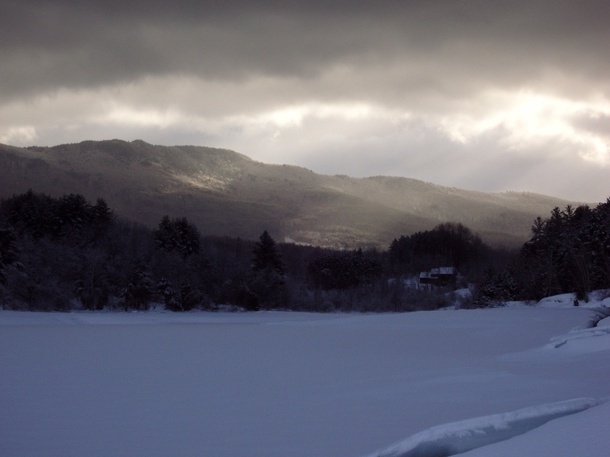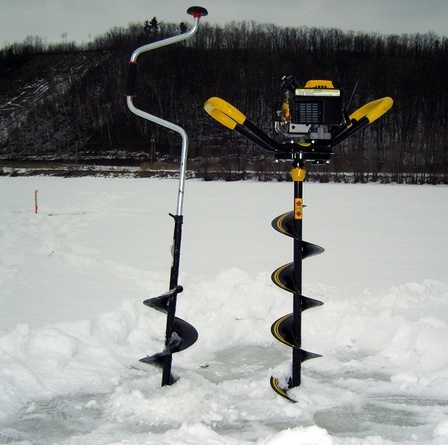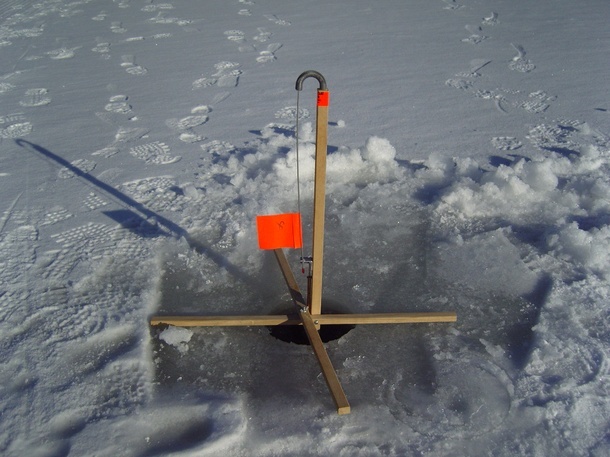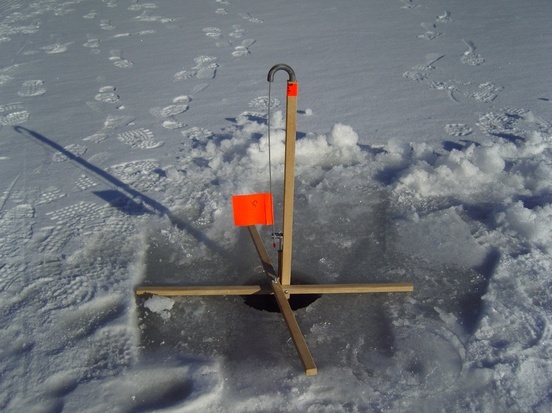To people who have never tried it, ice fishing is often seen as a ridiculous or comical winter pastime. After all, why would grown men and women haul themselves out of the comfort of warm homes to drill holes in frozen lakes just to catch a few fish? They sell fish at the supermarket, don’t they? There are also the inevitable jokes about ice fishing being little more than an excuse for grown men to get away from their wives and drink beer without fear of being nagged to complete a honey-do list. While there is a nugget of truth at the core of any stereotype, by and large, ice anglers are as devoted to and serious about their pursuit as warm weather anglers.
What follows is a brief guide to get the uninitiated, would-be, ice angler started in the sport without investing a tremendous amount of money.
Why Ice Fish?
The reasons people enjoy ice fishing will inevitably vary from person to person, but in general there are two underlying justifications for spending a day on the wind-swept surface of a frozen lake or pond. First and foremost, winter is the best time to target certain species of game fish, especially lake trout and landlocked salmon.
Throughout most of the open water fishing season, these fish lurk in the deepest portions of lakes and ponds. Catching them typically requires a boat equipped with a sonar unit, downriggers, and other specialized equipment, none of which is inexpensive. Once the surface of the lake freezes to a safe thickness in the winter, however, anyone who can walk can access prime trout and salmon fishing territory. Since these species thrive in cold water, they are just as active (if not more active) during the winter as during the warmer months and often move into shallower, easier to fish regions of lakes and ponds. Catching a trophy landlocked salmon in July will likely require thousands of dollars of equipment but during the winter all that is needed is a hook, line, and a hole in the ice.
The second reason to ice fish is emotional and psychological in nature. Winter is long and dark in many parts of the world. It is inevitable that cabin fever will affect even the most iron-willed individual at some point and feelings of claustrophobia will set in. Spending a day outside getting fresh air, exercise, and possibly a little winter sunshine goes a long way toward counteracting cabin fever. Sure, it’s cold out there, but being cold for a few hours will really make a person appreciate a warm home and hot shower at the end of a long day of fishing. Further, while a number of outdoor winter activities will provide a mood boost, ice fishing is the only one that offers a fresh fish dinner as a potential reward.

A frozen Vermont lake just after dawn. Vistas like this are sure to boost the mood of even the most winter-weary soul.
Basic gear
Like any other outdoor activity, the gear associated with ice fishing can be as simple and inexpensive or as expensive and complicated as the angler chooses. Minimally, however, the beginner will need the following items.
A way to make a hole in the ice
Technically, a hole can be made in the ice with a variety of tools including axes, spud bars and chippers, and chainsaws. The most practical and safest tool for the job is a hand operated or powered ice auger.
Gasoline, propane, and electric power augers are available through most hunting/fishing retailers and typically cost $400 or more new. While a power auger will save a great deal of labor when drilling multiple holes through thick ice, they are heavy, require the operator to bring fuel or large batteries, and are not immune to catastrophic mechanical failure. Additionally, the high price of power augers may be prohibitive to the novice.
A better option for the first time ice angler is a hand operated auger. A good hand auger can be purchased for $50 to $80 new and will cost significantly less used. A hand auger with sharp blades and a determined operator can bore through 12-inches of ice in less than a minute. Fatigue is inevitable if dozens of holes are drilled but then a little exercise is never a bad thing.

A hand auger (left) and a power auger (right). A power auger will bore through ice quickly while a hand auger will bore a hole in ice cheaply.
Rods, reels, and tip-ups
A length of line wound around a cleat will suffice as a very basic and inexpensive ice fishing outfit, but the first time ice angler is best served by investing in at least one ice fishing rod and reel combo and possibly a tip-up or two.
An ice fishing rod, also called a jigging rod or jigging stick resembles a miniature version of an open water rod/reel setup. The short length of the rod (typically 18 to 24 inches) allows the angler to use the rod within the confines of an ice tent or shelter. Reels for these setups are identical to those found on warm water rods and are wound with the same monofilament or braided lines. Some ice buildup on the line, guides, and in the spool is inevitable, but can be mitigated to a degree with application of unscented mineral oil to the line and guides.
An alternative tool for catching fish through the ice is the tip-up, which is a device equipped with a reel of line set to trigger a spring loaded flag in the event of a bite. Numerous makes and model of tip-up are available to consumers but beware of the ultra-inexpensive models often found in ice fishing starter kits at big box retailers. There are invariably poorly made, hold an insufficient amount of line, and are unlikely to last a season.
Lures, baits, and rigs
In a manner similar to open water fishing, an angler’s selection of lures will depend upon the target species. In general, jigs of varying size and style are preferred for ice fishing as they do not rely on casting and retrieving to achieve the desired action.
Where allowed by law, the use of live bait is highly effective for catching fish through the ice. Various baitfish including smelt, shiners, minnows, and small suckers are common ice fishing bait as are meal worms, maggots, and even earthworms.
More details on how and when to employ various ice fishing baits and lures will be provided in an upcoming article.
Clothing and comfort items
Selecting appropriate clothing for ice fishing can be a challenge due to the fact that a typical day on the ice consists of periods of activity (walking to a fishing spot, drilling holes) followed by periods of inactivity (watching tip-ups, jigging). This can create an uncomfortable and potentially dangerous situation where clothing, soaked with sweat from activity, becomes cold during sedentary periods.
It follows that bringing extra articles of clothing to replace sweat-soaked items is a prudent idea. Additionally, as is par for course when dressing for outdoor winter activities avoid cotton fabrics and dress in layers. Hand warmer and foot warmer packets are also an invaluable addition to an ice fishing kit.
Safety
It has been said that no ice is safe ice, but realistically that’s a little hyperbolic and off-putting. The number of ice fishing fatalities every year is statistically nonexistent and almost all ice fishing deaths could have been prevented with a dose of common sense.
For additional details on ice fishing safety, I will defer to a comprehensive guide published by the Minnesota Department of Natural Resources.
Planning your first trip
Instant gratification is crucial to fostering a lifelong interest in any activity and ice fishing is no exception. To ensure, to whatever extent possible, a fun and action packed first ice fishing trip, a novice would do well to locate a body of water with a large population of such fish as yellow perch, bluegill, and chain pickerel. These fish are voracious eaters and are highly active throughout the entire year. When these species are present in great numbers, it’s difficult to avoid catching them and a day of fast action is all but assured.
(1327)








